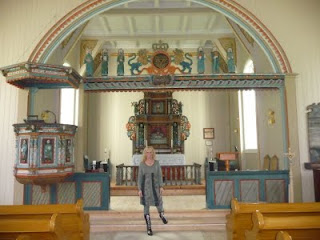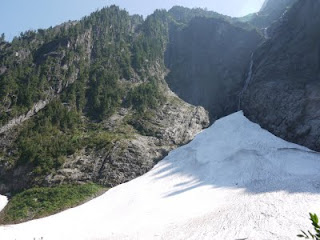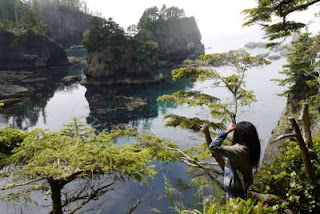 Christmas Day arrived, clear and white with frost. All seven of our children were spending their Christmases elsewhere, most of them far away. We’d thought Larry might come by bus from Spokane, but since he has no cell phone, no computer, and has never (so far as I know) written a letter, we just didn’t know if he’d show up. By noontime, we’d heard nothing so we decided to pack a picnic and enjoy a Christmas mini-getaway.
Christmas Day arrived, clear and white with frost. All seven of our children were spending their Christmases elsewhere, most of them far away. We’d thought Larry might come by bus from Spokane, but since he has no cell phone, no computer, and has never (so far as I know) written a letter, we just didn’t know if he’d show up. By noontime, we’d heard nothing so we decided to pack a picnic and enjoy a Christmas mini-getaway.We drove over the tree-shaded, frost-coated Mountain Loop Highway to the Robe Valley, one of our favorite getaway spots. I grew up here, and it's still home. We reached the Hemple Creek campground by 1:30. The sun had already dropped behind Mt. Pilchuck, throwing the empty park into twilight. We parked beside the Stillaguamish, looking upriver to where the sun still lit the Gold Basin cliffs. The picnic tables and benches glistened with frost crystals, so we opted to enjoy our home-made clam chowder and egg-salad sandwiches in the comfort of our van. While eating, we watched the shadows creep from the river toward the top of the cliffs.
Still thinking that Larry might find his way to our house and worried we’d not know he’d been there, Hank wished aloud that we had one of those leave-a-note boxes people used to hang beside their front doors.
I’d completely forgotten about those, but suddenly in my mind I saw the box we had, back in the days when we didn’t own a telephone and people often dropped by unannounced. My grandfather had crafted it of brown-varnished wood to look like a little house with a peaked roof. It was about 6 inches high and only an inch or so deep, with a door nearly the size of the entire front. The hook that held the door closed was also the doorknob. Scrawled across the front in yellow paint, "Leave a Note" announced its purpose. If we weren’t home, a visitor could write a message with the pad and pencil kept inside.
When the family returned from an excursion, the first person to the porch flipped open the little door and checked the message pad. It was like checking our telephone or e-mail messages today. If neighbors had stopped by, it was easy enough to walk down the road to see them. But if we’d missed friends or relatives from Granite Falls or Snohomish, there were always groans of disappointment. We had missed a chance for face-to-face contact and fun.
On the way back to town, Hank and I passed my childhood home with all its happy memories of Christmases past. I’m sure the people who now live there have no need of a “Leave a Note” box. But a thought flitted through my mind...do they ever wonder about the history that lingers in the little house where they are busy making their own memories? I hope they’re leaving happy “notes” for their children to remember.






 My dear friend Hazel went home to heaven a few years ago, but as I sorted through a pile of papers recently I found a quote she’d sent in 1987, after my young nephew Byron Wheatley died in a plane crash. It seemed to summarize her life’s philosophy. “Hold loosely everything that is not eternal.” Her letter ended with characteristic enthusiasm, “What a beautiful morning! Lets go somewhere and celebrate!”
My dear friend Hazel went home to heaven a few years ago, but as I sorted through a pile of papers recently I found a quote she’d sent in 1987, after my young nephew Byron Wheatley died in a plane crash. It seemed to summarize her life’s philosophy. “Hold loosely everything that is not eternal.” Her letter ended with characteristic enthusiasm, “What a beautiful morning! Lets go somewhere and celebrate!”
















 Every spring, snow avalanches fall from Big Four’s sheer cliffs and pack to glacier hardness. Cascading waterfalls burrow under the ice, forming caves that tempt the ignorant or foolhardy to enter. Almost every year, in spite of warning signs at the trailhead, someone is hurt. A few people have died under collapsing ice. The newspaper story in question was triggered by another such incident. Someone, probably climbing on the glaciers or the cliffs above, had slipped and fallen. Rescuers passed through one of the caves to help him, and got out just as chunks of ice came crashing down behind them.
Every spring, snow avalanches fall from Big Four’s sheer cliffs and pack to glacier hardness. Cascading waterfalls burrow under the ice, forming caves that tempt the ignorant or foolhardy to enter. Almost every year, in spite of warning signs at the trailhead, someone is hurt. A few people have died under collapsing ice. The newspaper story in question was triggered by another such incident. Someone, probably climbing on the glaciers or the cliffs above, had slipped and fallen. Rescuers passed through one of the caves to help him, and got out just as chunks of ice came crashing down behind them.

















 ather less calm than this, visitors hear waves crashing into the cliffs long before they see the ocean. On this day, we heard mostly the cries of seabirds echoing through the forest. Then the point narrowed. From either side of the trail we looked down into blue-green waters reflecting the sedimentary bluffs and sea stacks.* Arching caverns yawned deep into the bluffs. The scene looked like it hadn’t changed for an eternity, but a sign posted along the trail informed us that on a stormy day, we would feel waves crashing into those caves, shaking the whole point. Someday, who knows how far into the future, the roofs of the caves will collapse and the point we stood on will erode into the sea.
ather less calm than this, visitors hear waves crashing into the cliffs long before they see the ocean. On this day, we heard mostly the cries of seabirds echoing through the forest. Then the point narrowed. From either side of the trail we looked down into blue-green waters reflecting the sedimentary bluffs and sea stacks.* Arching caverns yawned deep into the bluffs. The scene looked like it hadn’t changed for an eternity, but a sign posted along the trail informed us that on a stormy day, we would feel waves crashing into those caves, shaking the whole point. Someday, who knows how far into the future, the roofs of the caves will collapse and the point we stood on will erode into the sea.




